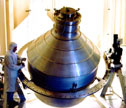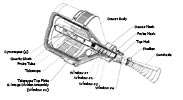WEEKLY UPDATE FOR 30 SEPTEMBER 2005:
GRAVITY PROBE B MISSION STATUS AT A GLANCE

| Item | Current Status |
| Mission Elapsed Time | 528 days (75 weeks/17.3 months) |
IOC Phase |
129 days (4.2 months) |
Science Phase |
352 days (11.6 months) |
Final Calibration Phase |
43 days |
Science II Phase |
4 days |
| Current Orbit # | 7,792 as of 4:00 PM PST |
| Spacecraft General Health | Good |
| Roll Rate | Normal at 0.4898 rpm (122.5 seconds per revolution) |
| Gyro Suspension System (GSS) | All 4 gyros digitally suspended |
| Dewar Temperature | 5.632 kelvin (and rising) |
| Global Positioning System (GPS) lock | Greater than 95.0% |
| Attitude & Translation Control (ATC) | X-axis attitude error: N/A |
| Command & Data Handling (CDH) | B-side (backup) computer in control Multi-bit errors (MBE): 0 Single-bit errors (SBE): 7 (daily average) |
| Telescope Readout (TRE) | Nominal |
| SQUID Readouts (SRE) | Nominal (temperature 7 kelvin & rising) |
| Gyro #1 rotor potential | +5.2 mV (as of 9/22) |
| Gyro #2 rotor potential | +4.2 mV (as of 9/22) |
| Gyro #3 rotor potential | +2.7 mV (as of 9/22) |
| Gyro #4 rotor potential | +5.0 mV (as of 9/22) |
| Gyro #1 Drag-free Status | OFF |
MISSION DIRECTOR'S SUMMARY
On Mission Day 528, the Gravity Probe B vehicle and payload are in good health, with all subsystems performing nominally. The Dewar is now depleted of liquid helium, and this has affected various subsystems, as summarized below. Drag-free mode has been turned off.


Yesterday at 1:55 pm Pacific Daylight Time, the last of the liquid helium in our Dewar transitioned to the gas phase, and the science instrument began to warm. The team correctly assessed the status of the Dewar, based on a set of pre-approved indicators, and they began running our planned Helium Depletion Procedure.

As of 9:30 am PDT this morning, the temperature in the Dewar had risen from 1.8 to 5.6 kelvin, and it is slowly continuing to rise. Likewise, the temperature in SQUID Readout Electronics (SRE) had risen to 7 kelvin, but as of our 10:00 am PDT status meeting this morning, the Dewar was still cold enough for the SRE to provide readouts of the gyros' spin axes. As the SRE temperature continues to rise, we will gradually lose these readouts.
This past Monday, 26 September 2005, we made a third attempt to switch from backup drag-free mode to primary drag-free mode on gyro #1. This latest attempt also failed, but for a different reason. Configuration issues were determined to be the root cause in each of the first two failures, and these issues were addressed prior to making this 3rd attempt on Monday. Analysis later this week showed that Monday's failed attempt was consistent with similar failures we had seen during the Initiialization and Orbit Checkout (IOC) phase of the mission in July and August, 2004, and it was likely due to un-modeled forces between the gyro rotor and its housing.

As was the case during IOC, these issues could have been resolved with further experimentation and fine tuning the Attitude and Translation Control system (ATC). However, given the imminent depletion of the Dewar's helium supply, we decided to return the spacecraft to its stable science configuration (backup drag-free mode, locked on the guide star) and remain in this configuration until the helium ran out--which as it turned out, happened three days later.
Our science team is interested in comparing the data collected in science configuration during this past week with the science data they collected prior to beginning gyro torque calibrations in mid August.
GP-B MISSION NEWS—THE DAY THE DEWAR DIED

As we have been anticipating for some time now, the moment finally arrived yesterday when the liquid helium in the Dewar ran out. I was sitting in my office, thinking about what I was going to write in this week's Mission News section when a colleague stopped by and said, “It appears that we've run out of helium.” Suddenly, my dilemma of what to write about this week was a non-issue.
I grabbed my camera and dashed off to our Mission Operations Center (MOC). In recent weeks, our MOC has been relatively quiet, and typically there have only been a handful of people there at any given time. But, yesterday afternoon, the MOC was teeming with activity, reminiscent of the days when we spun up the gyros in the summer of 2004.


The evidence was clearly visible on the Dewar monitor screen. The pressure display had suddenly taken a nose-dive. Elsewhere in the MOC, GP-B scientists and engineers were clustered around the status monitors representing their respective areas of expertise, engaged in animated conversations. Meanwhile, our mission operations team members, headphones and microphones in place, were communicating with a NASA ground station, arranging for extra telemetry time.


There were some tense moments when all were patiently awaiting the download of more data that would confirm, unequivocally, that the liquid helium was depleted. We were also attempting to turn on the Experiment Control Unit (ECU) on the spacecraft so that we could receive some important data, such as the current temperature in the Dewar. It took several hours to arrange all the necessary telemetry passes, send the required commands to the spacecraft, and download the all the spacecraft status data. By late evening, it was clear that the liquid helium in the Dewar had run out, and that the Dewar and SQUIDs were slowly beginning to warm up.

This morning, at our daily all hands meeting-the last of our daily spacecraft status meetings-the room was packed. The word was out that we had run out of helium, and everyone came to hear the details. At the end of the meeting, GP-B program manager, Gaylord Green, and GP-B principal investigator, Francis Everitt, each congratulated the team on their superb performance in working with one of the most complex spacecraft ever launched. We then assembled in front of the GP-B building for a group photo, and the next to last chapter in the long and colorful history of GP-B came to a close.
We will continue to post these weekly updates for another week or so, while we perform some final tests as the spacecraft warms up. We will then transition to less frequent updates-either bi-weekly or monthly-as there will be little news to report from week to week during the coming year of data analysis.
For now, we leave you with a song, written by Rob Brumley (our former gyro expert), Greg Gutt (one of our former SQUID experts), with help from Bill Bencze (our deputy program manager for engineering).
AMERICAN PIE--GYRO STYLE
(With apologies to Don McLean)
A long, long time ago....
I can still remember how that Dewar used to make me smile
And I knew if I had my chance
That I could make those gyros dance
And Francis would be happy for a while.
But September 1st had come and gone
The helium went on and on
No time for celebration
Another calibration....
I can't remember if I cried
Remembering how hard we'd tried
And I was filled with a sense of pride
The day the Dewar died....
REFRAIN
So, bye-bye, our friend in the sky
Tied my SQUID to the Dewar,
But the Dewar was dry,
And the good ol' boys, drinking coffee and wine,
Singing this'll be the day that I die,
This'll be the day that I die….
The gyros spun a little slow,
So Gaylord said increase the roll.
And gyro drift was truly low,
The day the Dewar died....
(We could use a few more lyrics here, so please feel free to help us out…)
REFRAIN
UPDATED NASA/GP-B FACT SHEET AVAILABLE FOR DOWNLOADING
We recently updated our NASA Factsheet on the GP-B mission and experiment. You'll now find this 6-page document (Adobe Acrobat PDF format) listed as the last navigation link under "What is GP-B" in the upper left corner of this Web page. You can also click here to download a copy.
Drawings & Photos: The photo of the Dewar at the top of the page was taken by Lockheed Martin photographer Russ Underwood. The photos of the micro thrusters, SQUID, and Dewar, and the cutaway drawings of the Dewar are from the GP-B Image Archive here at Stanford. The photos in the GP-B Mission Operations Center (MOC) and the photo of the GP-B team were taken by GP-B Public Affairs Coordinator, Bob Kahn. Click on the thumbnails to view these images at full size.
MORE LINKS ON RECENT TOPICS
- Track the satellite in the sky
- Photo, video & and news links
- Build a paper model of the GP-B Spacecraft
- Following the mission online
- Our mailing list—receive the weekly highlights via email
- The GP-B Launch Companion in Adobe Acrobat PDF format. Please note: this file is 1.6 MB, so it may take awhile to download if you have a slow Internet connection.
Previous Highlight
Index of Highlights
